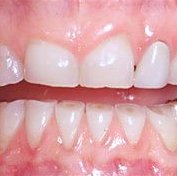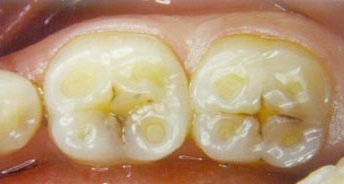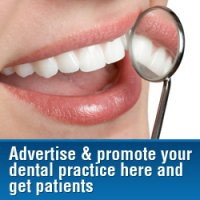
Teeth Grinding (Bruxism) Symptoms
Symptoms of bruxism, can vary from mildly irritating to dangerous for both dental and physical health, depending on the severity of the condition. In most cases, because grinding often occurs during sleep and damages caused by bruxism appear gradually, most people are unaware that they grind their teeth.
Bruxism Symptoms • Signs of Teeth Grinding
Early diagnosis of damage caused by severe bruxism often includes the following symptoms :
- Worn down teeth – abraded teeth. A person can actually grind their teeth so hard while asleep, that sometimes significant amounts of tooth structure can be lost over time.
 Usually it is the canines and incisors that move against each other in a side to side action. This abrades tooth enamel, removing the sharp biting surfaces and flattening the edges of the teeth.
The front teeth become worn to exactly the same length and the teeth look flat at the tips.
If bruxism involves the back teeth, worn cusp tips is a first symptom of teeth grinding. In some cases the loss of tooth enamel is even more than in severe tooth decay.
Damage to the tooth enamel makes it easier for bacteria to penetrate to the softer part of the teeth, increasing the possibility of tooth decay.
Usually it is the canines and incisors that move against each other in a side to side action. This abrades tooth enamel, removing the sharp biting surfaces and flattening the edges of the teeth.
The front teeth become worn to exactly the same length and the teeth look flat at the tips.
If bruxism involves the back teeth, worn cusp tips is a first symptom of teeth grinding. In some cases the loss of tooth enamel is even more than in severe tooth decay.
Damage to the tooth enamel makes it easier for bacteria to penetrate to the softer part of the teeth, increasing the possibility of tooth decay. - Fractures of teeth or fillings is a common symptom in bruxism patients.
- Tooth sensitivity – Teeth become sensitive to cold, pressure and other stimuli. Worn tooth enamel exposes the softer part of the tooth –the dentine- making the affected teeth susceptible to tooth sensitivity problems.
- Loose teeth – Increased teeth mobility – Teeth grinding keeps teeth under constant lateral motion. Although the motion is minor, by time it may lead to loss of supporting bone around the teeth resulting in loose teeth.
- Bony ridges - Instead of losing bone support, some people actually develop "extra" bone to support the teeth. These appear as bony ridges that can be seen and felt on the jawbones as a smooth raised area about the level of the roots.
- Cheek or tongue irritation - It is common for people with a bruxism problem to bite their tongue or inner cheek, especially close to the molars area.
- Annoying sounds while sleeping - Teeth grinding may be loud enough to annoy other family members and especially sleeping partners.
- TMJ problems - Chronic bruxism is one of the leading causes of TMJ syndrome. Some of the symptoms of temporomandibular joint disorders, that could be caused by bruxism, are :
- Sore jaw muscles – facial pain around the jaw or ears area when chewing.
- Frequent headaches or pain in the neck or shoulders.
- Clicking, locking or popping in the temporomandibular joint (TMJ).
- Ringing in the ears.
Teeth clenching puts teeth under high pressure. As a result, the edges of front teeth and the cusps of molar teeth may start to show micro-fractures or cracks. Eventually the teeth will break. In some cases the fracture goes deep down to the pulp area, requiring a root canal therapy.
Teeth grinding wears down the enamel, weakening the tooth structure. The force applied during teeth grinding may make the tooth structure to collapse, especially if it has restorations (fillings or crowns) due to previous tooth decay.
Bruxism diagnosis
As bruxism initially causes minor symptoms, people with sleep bruxism usually aren't aware of their habit or ignore it, until serious complications occur. Therefore, it is important to visit your doctor or dentist if you notice unusual wear of your teeth or pain in your jaw, face or ear or any other bruxism symptom.
During regular dental visits and examinations, your dentist will check for physical signs of bruxism. If bruxism symptoms are present, the dentist will observe the condition for changes over the next several visits before a treatment program is established. If you suspect that you have bruxism you can have a polysomnographic test performed. This tests looks for evidence of jaw muscle activity during the sleep.
A device called the BiteStrip enables at-home overnight testing for sleep bruxism and might help diagnose bruxism before damage appears on the teeth. The device is a miniature electromyograph machine that senses jaw muscle activity while the patient sleeps. A dentist can establish the frequency of bruxing, which helps in choosing a treatment plan.
Another approach to diagnose bruxism is the BruxChecker, a comparatively non-invasive, thin, transparent, polyvinyl chloride plate, painted red. Tooth grinding leaves clear marks on this thin plate, thus serving as confirmation of the bruxism diagnosis.
For most people, bruxism is an occasional problem of little consequence. But for others, teeth grinding and/or teeth clenching can cause TMJ disorders and permanent damage to the teeth. It is important for successful treatment of teeth grinding and clenching, that the dentist identifies correctly what causes bruxism, so that the proposed treatment will be suitable for the individual patient's needs.
![]() The cost involved with dental treatments can be significant and many patients may not afford it if they are not covered by their dental insurance.
Learn how to choose a dental insurance plan that will provide the best dental treatment to you and your family.
The cost involved with dental treatments can be significant and many patients may not afford it if they are not covered by their dental insurance.
Learn how to choose a dental insurance plan that will provide the best dental treatment to you and your family.



